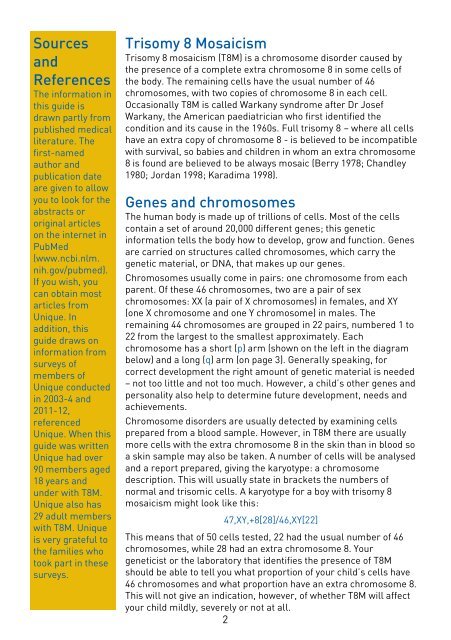Trisomy 8 Mosaicism - Unique - The Rare Chromosome Disorder ...
Trisomy 8 Mosaicism - Unique - The Rare Chromosome Disorder ...
Trisomy 8 Mosaicism - Unique - The Rare Chromosome Disorder ...
Create successful ePaper yourself
Turn your PDF publications into a flip-book with our unique Google optimized e-Paper software.
Sources<br />
and<br />
References<br />
<strong>The</strong> information in<br />
this guide is<br />
drawn partly from<br />
published medical<br />
literature. <strong>The</strong><br />
first-named<br />
author and<br />
publication date<br />
are given to allow<br />
you to look for the<br />
abstracts or<br />
original articles<br />
on the internet in<br />
PubMed<br />
(www.ncbi.nlm.<br />
nih.gov/pubmed).<br />
If you wish, you<br />
can obtain most<br />
articles from<br />
<strong>Unique</strong>. In<br />
addition, this<br />
guide draws on<br />
information from<br />
surveys of<br />
members of<br />
<strong>Unique</strong> conducted<br />
in 2003-4 and<br />
2011-12,<br />
referenced<br />
<strong>Unique</strong>. When this<br />
guide was written<br />
<strong>Unique</strong> had over<br />
90 members aged<br />
18 years and<br />
under with T8M.<br />
<strong>Unique</strong> also has<br />
29 adult members<br />
with T8M. <strong>Unique</strong><br />
is very grateful to<br />
the families who<br />
took part in these<br />
surveys.<br />
<strong>Trisomy</strong> 8 <strong>Mosaicism</strong><br />
<strong>Trisomy</strong> 8 mosaicism (T8M) is a chromosome disorder caused by<br />
the presence of a complete extra chromosome 8 in some cells of<br />
the body. <strong>The</strong> remaining cells have the usual number of 46<br />
chromosomes, with two copies of chromosome 8 in each cell.<br />
Occasionally T8M is called Warkany syndrome after Dr Josef<br />
Warkany, the American paediatrician who first identified the<br />
condition and its cause in the 1960s. Full trisomy 8 – where all cells<br />
have an extra copy of chromosome 8 - is believed to be incompatible<br />
with survival, so babies and children in whom an extra chromosome<br />
8 is found are believed to be always mosaic (Berry 1978; Chandley<br />
1980; Jordan 1998; Karadima 1998).<br />
Genes and chromosomes<br />
<strong>The</strong> human body is made up of trillions of cells. Most of the cells<br />
contain a set of around 20,000 different genes; this genetic<br />
information tells the body how to develop, grow and function. Genes<br />
are carried on structures called chromosomes, which carry the<br />
genetic material, or DNA, that makes up our genes.<br />
<strong>Chromosome</strong>s usually come in pairs: one chromosome from each<br />
parent. Of these 46 chromosomes, two are a pair of sex<br />
chromosomes: XX (a pair of X chromosomes) in females, and XY<br />
(one X chromosome and one Y chromosome) in males. <strong>The</strong><br />
remaining 44 chromosomes are grouped in 22 pairs, numbered 1 to<br />
22 from the largest to the smallest approximately. Each<br />
chromosome has a short (p) arm (shown on the left in the diagram<br />
below) and a long (q) arm (on page 3). Generally speaking, for<br />
correct development the right amount of genetic material is needed<br />
– not too little and not too much. However, a child’s other genes and<br />
personality also help to determine future development, needs and<br />
achievements.<br />
<strong>Chromosome</strong> disorders are usually detected by examining cells<br />
prepared from a blood sample. However, in T8M there are usually<br />
more cells with the extra chromosome 8 in the skin than in blood so<br />
a skin sample may also be taken. A number of cells will be analysed<br />
and a report prepared, giving the karyotype: a chromosome<br />
description. This will usually state in brackets the numbers of<br />
normal and trisomic cells. A karyotype for a boy with trisomy 8<br />
mosaicism might look like this:<br />
47,XY,+8[28]/46,XY[22]<br />
This means that of 50 cells tested, 22 had the usual number of 46<br />
chromosomes, while 28 had an extra chromosome 8. Your<br />
geneticist or the laboratory that identifies the presence of T8M<br />
should be able to tell you what proportion of your child’s cells have<br />
46 chromosomes and what proportion have an extra chromosome 8.<br />
This will not give an indication, however, of whether T8M will affect<br />
your child mildly, severely or not at all.<br />
2

















